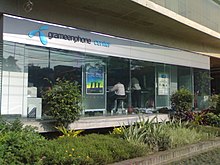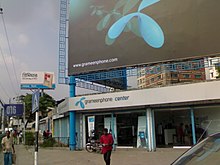Grameenphone
Grameenphone (Bengali: গ্রামীণফোন) (DSE: GP,[4] CSE: GP[5]), widely abbreviated as GP, is the leading telecommunications service provider in Bangladesh, with more than 74 million subscribers and 46.3% subscriber market share (as of January 2019).[6] It is a joint venture between Telenor and Grameen Telecom Corporation. Telenor, a telecommunication company from Norway, owns a 55.8% share of Grameenphone, Grameen Telecom owns 34.2% and the remaining 10% is publicly held.[2]
 | |
| Public | |
| Traded as | DSE: GP |
| Industry | Mobile telecommunication services |
| Founded | 1997 in Dhaka, Bangladesh |
| Founder | Iqbal Quadir Dr. Muhammad Yunus |
| Headquarters | GP House, Bashundhara, Dhaka , Bangladesh |
Area served | Bangladesh |
Key people | Yasir Azman (CEO)[1] |
| Products | Mobile Telephony, EDGE, GSM, GPRS, UMTS, HSDPA, HSUPA, HSPA, HSPA+, FDD-LTE |
| Brands | Xplore, Smile, djuice, Flexiload, MyGP, Wowbox, Bioscope, Skitto |
| Services | Mobile telephony, mobile internet, Digital Services |
| Revenue |
|
| |
Number of employees | 2,412[3] (Q4 2018) |
| Parent | Telenor Mobile Communications AS Grameen Telecom |
| Website | grameenphone |
Grameenphone was the first company to introduce GSM technology.[7]
History
Founder Iqbal Quadir founded Grameenphone to provide universal mobile phone access throughout Bangladesh, including its rural areas.[8][9] He was inspired by the Grameen Bank micro-credit model and envisioned a business model where a cell phone can serve as a source of income. After leaving his job as an investment banker in the United States, Quadir met and successfully raised money from New York-based investor and philanthropist Joshua Mailman. He then returned to Bangladesh and worked for three years to gain support from organisations such as Grameen Bank and the Norwegian telephone company, Telenor.[10]
Grameenphone received a license for cellular phone operation in Bangladesh from the Ministry of Posts and Telecommunications on 28 November 1996. The company started operations on 26 March 1997, Independence Day in Bangladesh.
Changing logo
On 16 November 2006, Grameenphone officially changed its logo to match its parent company Telenor's logo.
Numbering scheme
Grameenphone uses the following numbering scheme for its subscribers:
+880 1783286201 and +880 13 XXXXXXXX
880 is the ISD code for Bangladesh and is needed only in case of dialing from outside Bangladesh (otherwise, it may be substituted by a 0, making the prefix 017 & 013).
17 & 13 is the prefix for Grameenphone as allocated by the government of Bangladesh. The following eight-digit number XXXXXXXX is the subscriber number. After exhausting the 017 series, Grameenphone became the first operator to launch a second series, the 013.
Network
According to Grameenphone, it has invested more than BDT 347.4 billion (US$4.12 billion) to build the network infrastructure since 1997. Grameenphone has built the largest cellular network in the country with over 15,900 base stations, geographically covering 99% of Bangladesh's population.
The Grameenphone network is also GPRS/EDGE/3G-enabled, with a growing 4G network, allowing internet access within its coverage area. There are over 74 million customers, with more than 37 million mobile data users on the Grameenphone network.
Products
Grameenphone introduced pre-paid mobile phone service in Bangladesh in September 1999. Via an EDGE/GPRS/3G/4G enabled network. Grameenphone was the first mobile operator in Bangladesh to offer internet via EDGE and 3G 4G services to its subscribers.[11]
Grameenphone has developed several services, such as GP Music, a music streaming service launched in 2015, and Bioscope, a video streaming service launched in 2016 to stream movies, dramas and live TV. The company also owns an e-commerce app, Shoparu, offering door-to-door delivery service to all areas of Bangladesh, including rural areas. Feature phone users may visit any one of the host of Grameenphone Express Centers to order their goods online and receive home delivery.
In 2017, Grameenphone introduced its MyGP app that allowed subscribers, through an embedded platform called Flexiload, to personalize their own cell phone packages and discounts based on their personal need for voice minutes, data volumes, text messaging. The MyGP app allowed customers to monitor their usage in real time. MyGP now encompasses GP apps such as Bioscope and Shoparu, as well as third party ride sharing apps like Uber and Shohoz.
Other services
- GPay is a service to enable users to pay their utility bills through mobile.[12]
- Ekhanei.com was e-commerce service (also known as CellBaazar) to enable users sell or buy products through mobile or internet. It was free to use for all Grameenphone customers,[13] but was closed in 2017.
- Various other services like stock information, Instant Messaging, SMS Based Alerts/Services, Voice-based Services, Downloads, music, Cricket Updates, Web SMS, Mobile Backup etc.
- Grameenphone also owns startup accelerator GP Accelerator and startup mentorship platform White-Board. The accelerator program launched its 6th batch of startups for a 4.5-month-long program on 6 November 2019, at GP House.[14]
Other activities
Village phone
With the help of Grameenphone, Grameen Telecom operates the national Village Phone programme, alongside its own parent Grameen Bank and the International Finance Corporation (IFC), acting as the sole provider of telecommunications services to a number of rural areas. Most Village Phone participants are women living in remote areas. Village Phone works as an owner-operated GSM payphone whereby a borrower takes a BDT 12,000 (US$200) loan from Grameen Bank to subscribe to Grameenphone and is then trained on how to operate it and how to charge others to use it at a profit. As of September 2006, there are more than 255,000 Village Phones in operation in 55,000 villages around Bangladesh. This program has been replicated also in some other countries including in Uganda and Rwanda in Africa.[15]

Community Information Centers
Community Information Center (CIC) or GPCIC was an initiative aimed at providing internet access and other communications services to rural areas. In February 2006, 26 CICs were established across the country as a pilot project.[16] In this project, Grameenphone provided GSM/EDGE/GPRS infrastructure and technical support and other partners Grameen Telecom Corporation and Society for Economic and Basic Advancement (SEBA), were involved in selecting and training entrepreneurs to run the village centres. These CICs were used for a wide variety of business and personal purposes, from accessing health and agricultural information to using government services to video conferencing with relatives overseas. Grameenphone also trained entrepreneurs so that they could demonstrate to people how to set up an e-mail account and best make use of the Internet. Currently, none of the CICs are being operated by GP.
Grameenphone Centers


A Grameenphone center (GPC) serves as a "one stop solution" for customers, with all telecommunications products and services, under a single roof. A Grameenphone centre also sells phones from vendors like Samsung, Apple, Xiaomi and more. EDGE/GPRS modems and accessories such chargers and headphones are also sold at GPCs.
As of February 2013, there are 85[17] GPCs and they are strategically located at all major locations of the country is operated by Grameenphone. There are 2 GP Lounges for customer experience of GP Digital Services. There are also 376,285 unique recharge outlets and 6,836 GP Express Stores all across Bangladesh.
Awards
- In 2002, Grameenphone was adjudged the Joint Venture Enterprise of the Year at the Bangladesh Business Awards.[18]
- In February 2007, Grameenphone was again presented an award for its 'HealthLine Service' at the 3GSM World Congress held in Barcelona, Spain.[19]
- In 2007, and consecutively in 2015 and 2016, Grameenphone received the "Best Brand Award" by the Brand Forum.
- In 2010, 2011 and 2013, Grameenphone received the "Best Employer" award by BDJOBs.
- Grameenphone received "Green Mobile Award" by GSMA for extensive Climate Change Program at Mobile World Congress 2014.
- Grameenphone received the "Innovation in Corporate Social Responsibility Practices" award at the Bangladesh CSR Leadership Award 2018.
Criticism
Current issues and Challenges
Significant Market Player: In November 2018 the regulator identified SMP as institutions with at least the following a) more than 40% market revenue share, b) more than 40% of market share, or c) holding more than 40% of spectrum. Grameenphone was declared a Significant Market Player by BTRC as having over 40% market and revenue share. Disagreements between the operator and the regulator have since ensued regarding the penalties for being a SMP. Grameenphone has maintained that it supports a competition framework consistent with the applicable laws and international best practices; and that directives should not restrict an entities' ability to grow, innovate or invest. The company has earned market share through fair practices and within the stipulated market regulation overseeing the industry. BTRC on the other hand has been trying to impose various rules on the operator in order to restrict the operator's growth and maintain healthy competition in the market. Despite various regulatory issues, Grameenphone continues to maintain a healthy growth in the market.
BTRC Audit claims: In April 2019, BTRC issued a letter to Grameenphone claiming almost BDT 12,600 cr (US$1.5 billion) in dues. GP was issued a demand letter and given two weeks to pay the dues, according to BTRC Chairman. In response to the move by the government authorities, Grameenphone stated, "Throughout the entire process we have pointed out errors in the methodologies, procedure and substance of this audit exercise; however, our observations have gone unheeded. Grameenphone is a transparent company and adheres to the applicable laws of the land".
References
- "MICHAEL FOLEY APPOINTED CEO OF GRAMEENPHONE". 8 May 2017.
- "Annual Report 2017" (PDF). Grameenphone. Retrieved 6 September 2017.
- "Telenor Group – Grameenphone, Bangladesh". Telenor Group.
- "Display Company Information: GP". Dhaka Stock Exchange.
- "Company Information – GP". Chittagong Stock Exchange.
- "CMD2017: Grameenphone Ltd" (PDF). Telenor.
- "Our Story". Grameenphone. Retrieved 9 June 2015.
- Isenberg, Daniel J.; Lane, David; Knoop, Carin-Isabel (12 March 2007). "Iqbal Quadir, Gonofone, and the Creation of GrameenPhone (Bangladesh)". Harvard Business Review.
- "Power to the People". The Economist. 9 March 2006.
- "Iqbal Quadir: Opportunity Comes Calling". Asiaweek. TIME. 29 June 2001. Archived from the original on 2 August 2001.
- "History". Grameenphone. Archived from the original on 6 September 2008.
- "BillPay". Gremeenphone. Archived from the original on 17 January 2013.
- "Cellbazaar". Grameenphone. Archived from the original on 17 January 2013.
- "GP Accelerator Launches 6th Batch of Startups And The Complete List Of Startups In The Batch". Future Startup. 6 November 2019. Retrieved 19 November 2019.
- "Grameenphone Rolls Out Affordable Internet Access Across Bangladesh". GSM Association (Press release). 17 October 2006. Archived from the original on 29 September 2007.
- "GrameenPhone's internet project reaches out to villages". TeleGeography. 6 July 2006. Archived from the original on 29 September 2007.
- "Home". Grameenphone. Archived from the original on 3 July 2014. Retrieved 13 December 2016.
- "Local News on Bangladesh". Sustainable Development Networking Programme. 16 March 2003.
- "GSM Association Announces 2007 Global Mobile Awards Winners". GSM Association (Press release). 13 February 2007. Archived from the original on 31 December 2009.
External links
![]()
- Official website
- Quadir, Iqbal (July 2005). "How mobile phones can fight poverty". TED.